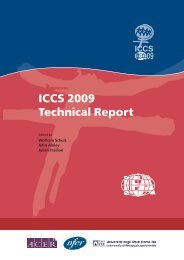Teacher Education and Development Study in Mathematics - IEA
Teacher Education and Development Study in Mathematics - IEA
Teacher Education and Development Study in Mathematics - IEA
You also want an ePaper? Increase the reach of your titles
YUMPU automatically turns print PDFs into web optimized ePapers that Google loves.
PART 2: KOREA, REPUBLIC OF<br />
111<br />
Korea, Republic of 13<br />
Composition of the teacher labor force<br />
Elementary schools have suffered from a teacher shortage <strong>in</strong> recent years, ma<strong>in</strong>ly<br />
because a sudden reduction <strong>in</strong> the teacher retirement age <strong>in</strong> 1999 saw a large number<br />
of teachers choos<strong>in</strong>g to take a favorable early retirement package. Secondary schools,<br />
however, have had the opposite problem of a very large oversupply of c<strong>and</strong>idates vy<strong>in</strong>g<br />
for a limited number of spots. There is close to a 5:1 ratio of c<strong>and</strong>idates to positions<br />
available, mostly because the government <strong>and</strong> teacher education <strong>in</strong>stitutions have failed<br />
to control the number of students enter<strong>in</strong>g these <strong>in</strong>stitutions. In numerical terms, about<br />
5,000 elementary school c<strong>and</strong>idates are supplied every year by the national universities<br />
of education, <strong>and</strong> about 25,000 secondary school c<strong>and</strong>idates are supplied through other<br />
<strong>in</strong>stitutions of education. Therefore, while a number of excellent students compete for<br />
spots <strong>in</strong> elementary schools, highly qualified students shy away from secondary schools.<br />
This oversupply of the secondary school teach<strong>in</strong>g workforce has led to a weaken<strong>in</strong>g of<br />
secondary school teacher education.<br />
The total number of teachers <strong>in</strong> 2002 was 357,084. Of this number, nearly 21% were <strong>in</strong><br />
high schools, just over 11% <strong>in</strong> vocational schools, nearly 27% <strong>in</strong> middle schools, <strong>and</strong><br />
just over 41% <strong>in</strong> elementary schools. The ratio of female to male teachers has <strong>in</strong>creased<br />
rapidly over the last two decades, with female teachers compris<strong>in</strong>g roughly 68% of the<br />
teacher workforce <strong>in</strong> 2002. The proportion of female teachers <strong>in</strong> that year was 71% <strong>in</strong><br />
elementary schools, 61% <strong>in</strong> middle schools, <strong>and</strong> 32% <strong>in</strong> high schools. Females cite the<br />
still high social status accorded to teachers <strong>and</strong> the favorable maternity leave policy as<br />
their ma<strong>in</strong> reasons for choos<strong>in</strong>g the teach<strong>in</strong>g profession.<br />
Rapid <strong>in</strong>dustrialization, economic growth, <strong>and</strong> many new, f<strong>in</strong>ancially reward<strong>in</strong>g<br />
employment options <strong>in</strong> the 1980s <strong>and</strong> 1990s lowered the aptitude of those choos<strong>in</strong>g<br />
to enter the teach<strong>in</strong>g profession. Talented <strong>in</strong>dividuals who had graduated from<br />
<strong>in</strong>stitutions of education moved <strong>in</strong>to these newly opened sectors, <strong>and</strong> some teachers<br />
left schools for better-pay<strong>in</strong>g jobs. This factor, along with those mentioned above,<br />
contributed to the teacher shortages with<strong>in</strong> the elementary schools. In the late 1990s,<br />
however, South Korea’s economy went through a recession <strong>and</strong> <strong>in</strong>dividuals were once<br />
aga<strong>in</strong> attracted to the stable nature of the elementary school teach<strong>in</strong>g profession. High<br />
school graduates with excellent achievement backgrounds began <strong>in</strong>creas<strong>in</strong>gly to enter<br />
elementary school teacher education <strong>in</strong>stitutions because elementary schools offered<br />
ready employment opportunities. Women, who still experience discrim<strong>in</strong>ation <strong>in</strong> other<br />
job sectors, especially f<strong>in</strong>d the prospect of teach<strong>in</strong>g <strong>in</strong> elementary schools attractive;<br />
78% of the entrants <strong>in</strong>to elementary teacher education <strong>in</strong>stitutions are females with<br />
excellent academic records. If the government did not set a quota on the number of<br />
female applicants, the proportion would be over 90%.<br />
In contrast, the oversupply of secondary school teachers means that the number of<br />
highly qualified applicants to secondary school teacher education <strong>in</strong>stitutions is<br />
decl<strong>in</strong><strong>in</strong>g quickly. In like manner, scores on the university entrance exam<strong>in</strong>ation that<br />
applicants must pass <strong>in</strong> order to enter teacher education <strong>in</strong>stitutions have dropped <strong>in</strong><br />
recent years. Secondary school teacher quality has further decl<strong>in</strong>ed because of potential<br />
applicants be<strong>in</strong>g deterred by the more negative social image of teachers that has recently<br />
13 Referred to as South Korea throughout this section.

















